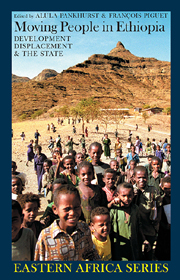Book contents
- Frontmatter
- Contents
- Acknowledgements
- Acronyms
- Glossary
- Notes on Contributors
- Preface: An Original Contribution to Country-wide Displacement Analysis
- Foreword by Alula Pankhurst & François Piguet
- Map
- Part I INTRODUCTION
- Part II THEORETICAL & INTERNATIONAL PERSPECTIVES
- Part III DEVELOPMENT-INDUCED DISPLACEMENT
- Part IV THE EXPERIENCE OF STATE-ORGANIZED RESETTLEMENT
- Part V THE DILEMMAS OF REFUGEES, RETURNEES & DISPLACED GROUPS
- 12 In the Mouth of the Lion
- 13 Returnees' Experiences of Resettlement in Humera
- 14 War, Displacement & Coping
- 15 From Young Soldiers to Adult Civilians
- Part VI CONCLUSION
- Bibliography
- Index
- EASTERN AFRICAN STUDIES
13 - Returnees' Experiences of Resettlement in Humera
from Part V - THE DILEMMAS OF REFUGEES, RETURNEES & DISPLACED GROUPS
Published online by Cambridge University Press: 05 April 2013
- Frontmatter
- Contents
- Acknowledgements
- Acronyms
- Glossary
- Notes on Contributors
- Preface: An Original Contribution to Country-wide Displacement Analysis
- Foreword by Alula Pankhurst & François Piguet
- Map
- Part I INTRODUCTION
- Part II THEORETICAL & INTERNATIONAL PERSPECTIVES
- Part III DEVELOPMENT-INDUCED DISPLACEMENT
- Part IV THE EXPERIENCE OF STATE-ORGANIZED RESETTLEMENT
- Part V THE DILEMMAS OF REFUGEES, RETURNEES & DISPLACED GROUPS
- 12 In the Mouth of the Lion
- 13 Returnees' Experiences of Resettlement in Humera
- 14 War, Displacement & Coping
- 15 From Young Soldiers to Adult Civilians
- Part VI CONCLUSION
- Bibliography
- Index
- EASTERN AFRICAN STUDIES
Summary
Introduction
This chapter examines the merits and drawbacks of resettlement as a feasible alternative for addressing problems affecting ex-refugees (or returnees) and other vulnerable groups. The heavy dependence on the agricultural sector rendered rural land settlement increasingly attractive to policy-makers and planners as a means of overcoming a host of problems. In embarking on resettlement, it is assumed that prevalent problems such as food insecurity, rural unemployment, and land fragmentation and marginality can be overcome. Policy-makers expect that moving people to areas with agricultural potential can offset the disadvantages accruing from the concentration of population in localities where intensive farming has long been heavily entrenched. Since the 1960s, Ethiopia has adopted planned resettlement programmes in the hope of solving all kinds of socio-economic and political problems. Planned land settlement in Ethiopia gained wider currency from the mid-1970s following the revolutionary process. Prior to this, resettlement programmes were mainly designed to address isolated local problems with limited objectives.
The chapter highlights aspects of resettlement relevant to concerns relating to returnees based on a case study of two returnee resettlement schemes in the Humera District, Western Tigray.
- Type
- Chapter
- Information
- Moving People in EthiopiaDevelopment, Displacement and the State, pp. 199 - 209Publisher: Boydell & BrewerPrint publication year: 2009

